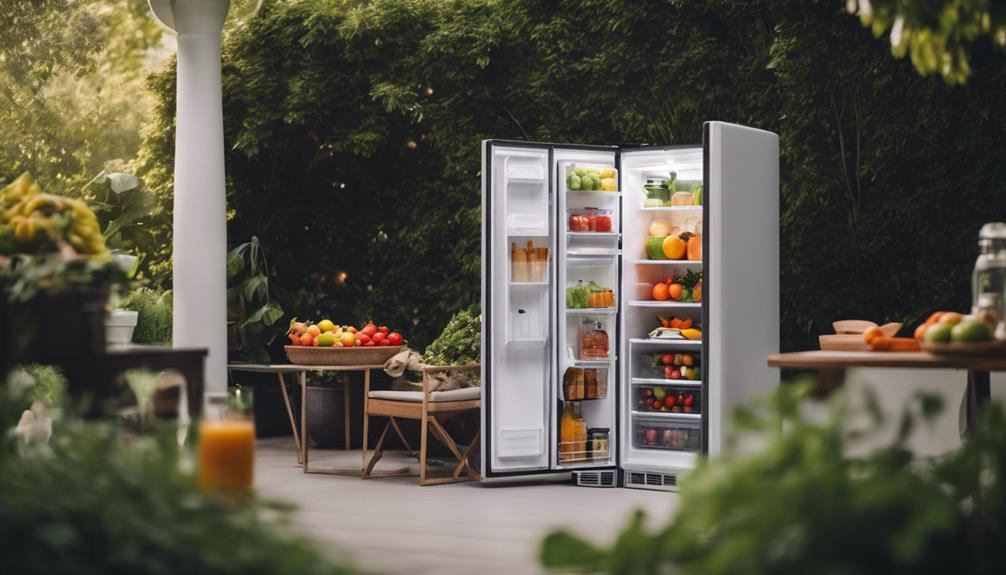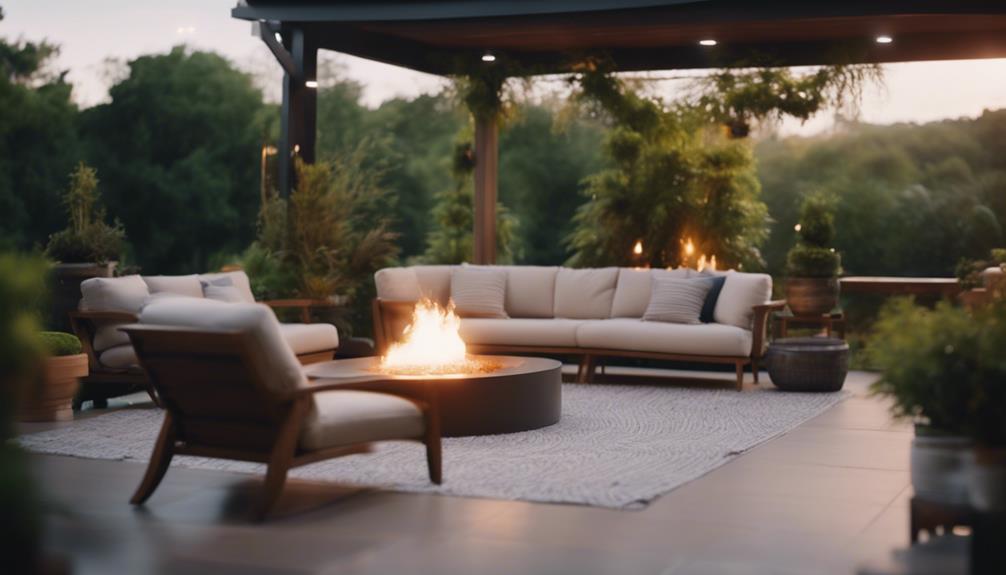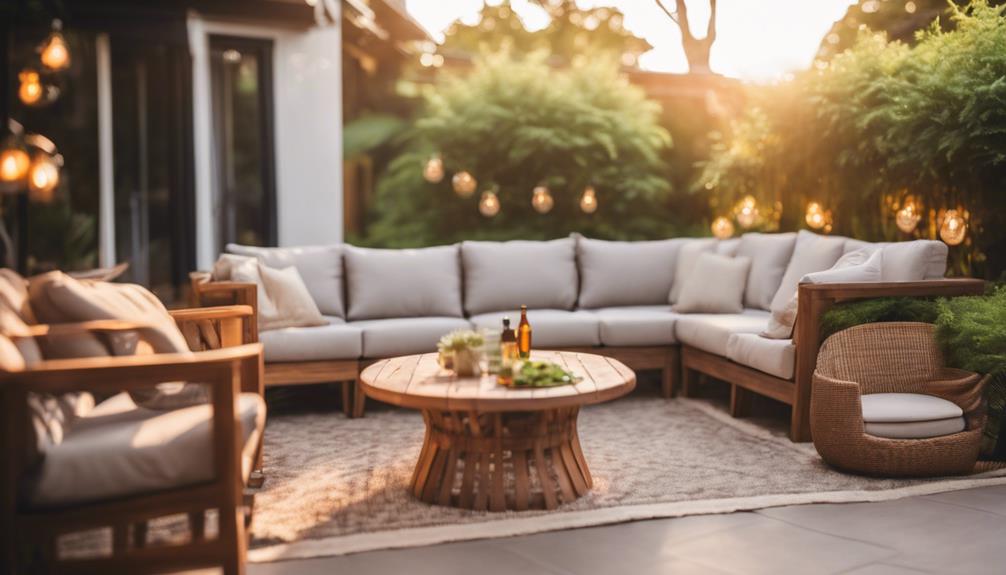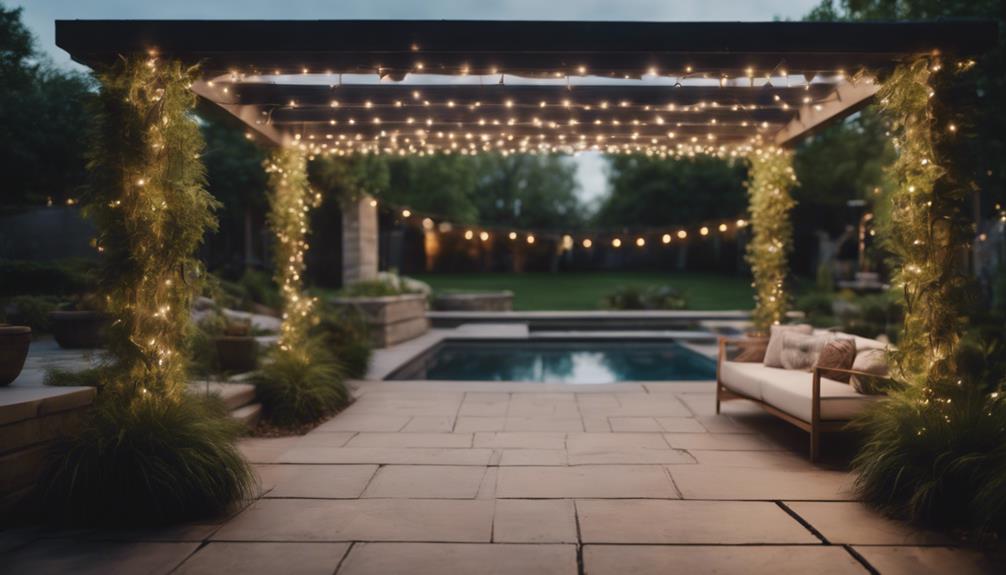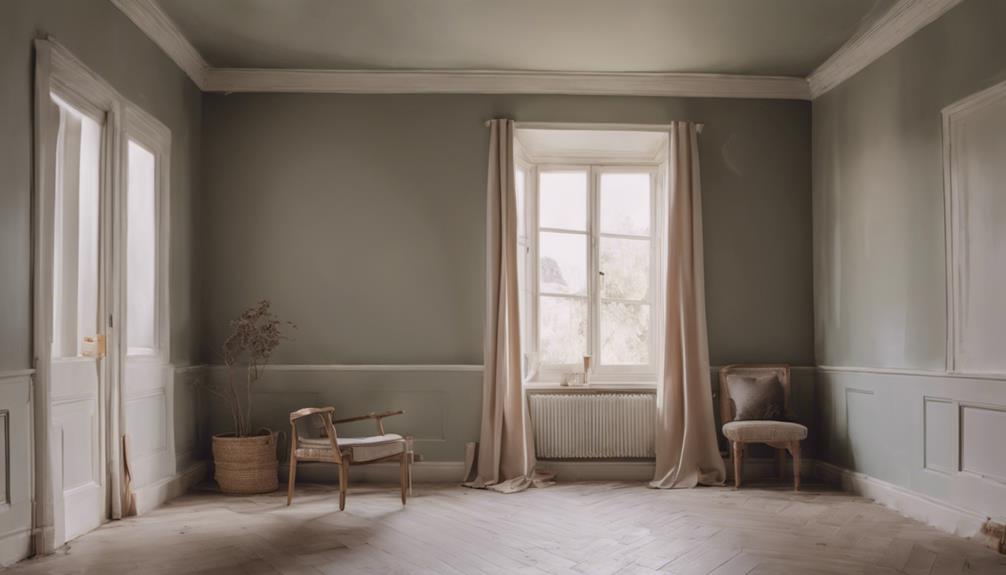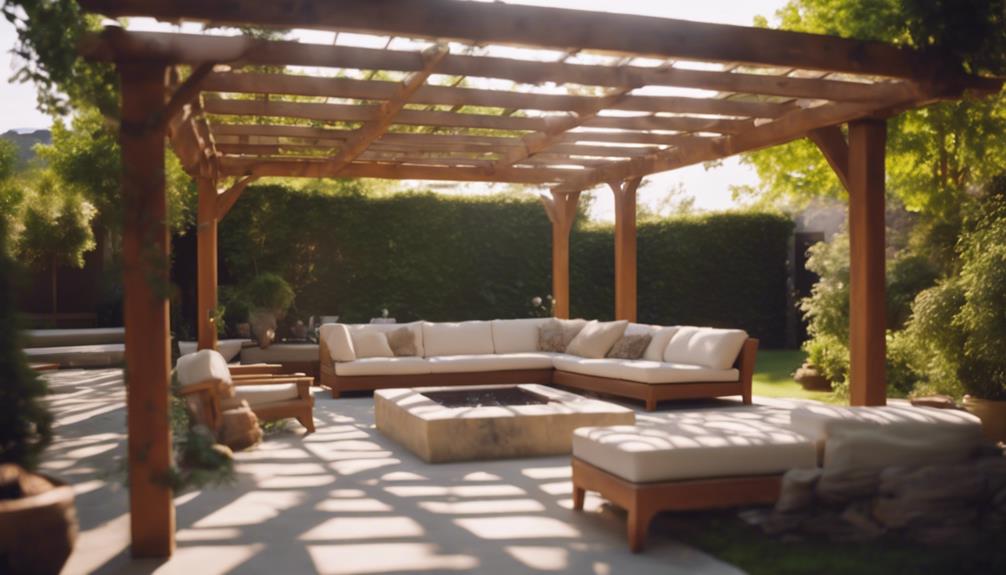You've invested time and money into creating the perfect outdoor space, and an alfresco fridge is the perfect addition to take your gatherings to the next level. Imagine having cold drinks and fresh food at your fingertips, without having to run back and forth to the indoor kitchen. Alfresco fridges offer convenience, flexibility, and ample storage space, all while keeping your food and drinks fresh and accessible. With durable construction, adjustable shelves, and digital controls, you'll be the ultimate host. And, with energy-efficient designs, you'll save money on electricity bills too. Want to know more about how an alfresco fridge can elevate your outdoor entertaining game?
Key Takeaways
- Alfresco fridges provide convenient access to chilled food and drinks, eliminating the need for frequent trips to the indoor kitchen.
- Durable construction with weather-resistant materials and additional insulation ensures consistent cooling performance in outdoor settings.
- Adjustable shelves and digital controls allow for customized storage and easy temperature management, keeping food and drinks fresh for outdoor entertaining.
- Energy-efficient design and advanced insulation minimize energy consumption, reducing electricity bills and promoting an environmentally friendly lifestyle.
- Proper installation and regular maintenance, including cleaning and door seal checks, are essential to ensure optimal performance and longevity of the alfresco fridge.
Benefits of Outdoor Refrigeration
Having an outdoor refrigerator at your disposal can revolutionize the way you entertain and cook outdoors, providing unparalleled convenience and flexibility. You'll be able to keep your food and drinks cold and within reach, making outdoor gatherings and barbecues a breeze.
Imagine being able to grab a cold drink or snag a snack without having to run back and forth to your indoor kitchen. With an Alfresco outdoor refrigerator, you can do just that. You'll have ample storage space to keep all your outdoor kitchen essentials chilled, from fresh veggies to cold cuts.
This means you can focus on what really matters – enjoying quality time with friends and family. Plus, having an outdoor refrigerator eliminates the need to constantly trek back and forth between your indoor kitchen and outdoor cooking space, freeing up more time for fun and relaxation.
Features to Look for in Alfresco Fridges
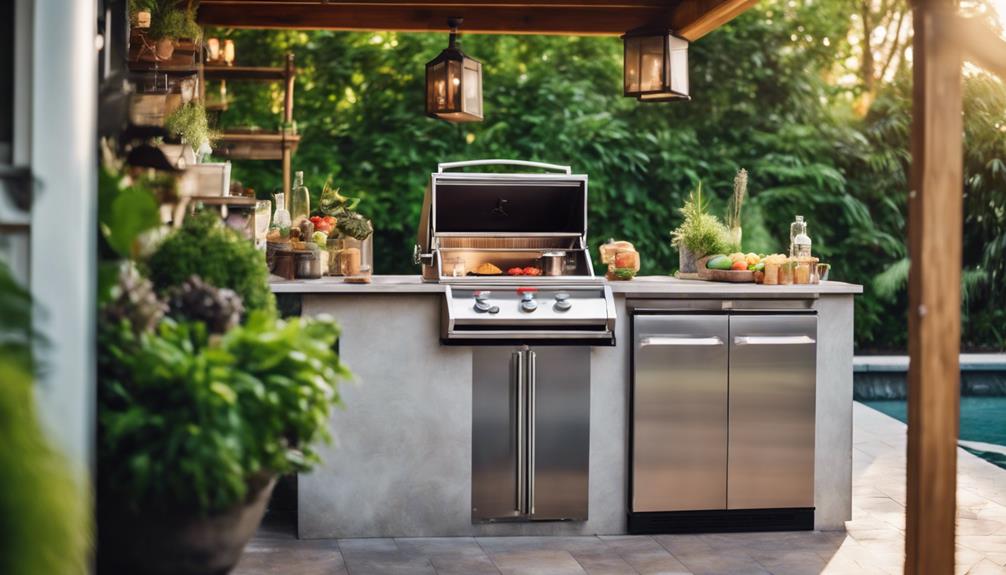
When selecting the perfect Alfresco fridge for your outdoor kitchen, look for features that guarantee durability, customization, and consistent performance. You want a fridge that can withstand the elements and keep your food fresh for outdoor gatherings.
First, opt for a fridge with stainless steel construction, which guarantees both durability and a sleek aesthetic. Adjustable shelves made of stainless steel are also a must, allowing you to customize storage to fit your specific needs.
For consistent temperature distribution, look for Alfresco fridges with fan-driven cooling, which assures your food stays at the perfect temperature. A digital control with a lighted display makes it easy to manage the temperature, so you're always in control.
Durable Construction for Outdoor Use
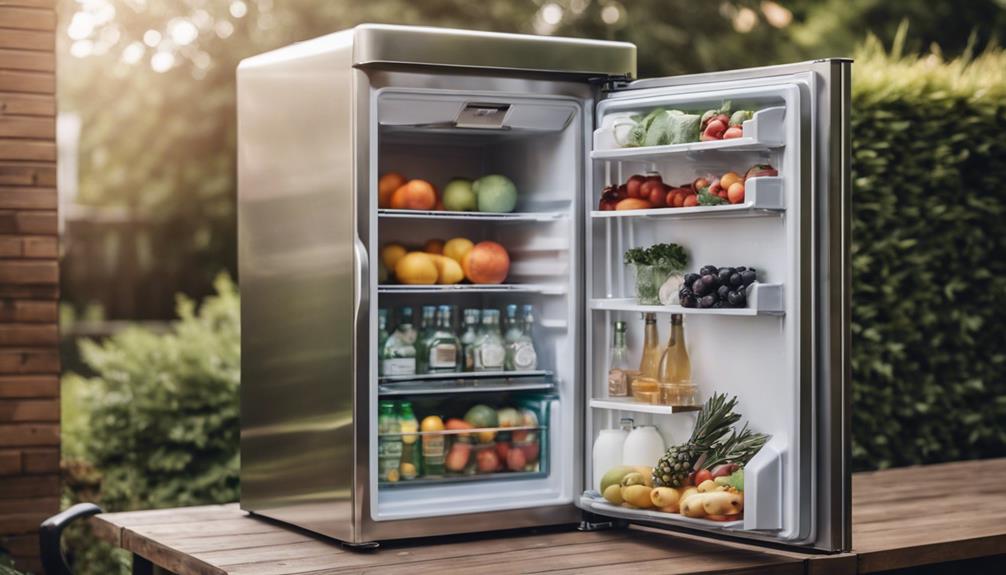
When you're shopping for an alfresco fridge, you're not just looking for a pretty face – you need something that can withstand the great outdoors.
That's why you should look for a fridge built with weather-resistant materials and a rugged outdoor design that can handle whatever Mother Nature throws its way.
Weather-Resistant Materials Used
Constructed from weather-resistant materials like stainless steel or aluminum, Alfresco outdoor refrigerators are built to withstand the harsh outdoor elements that can compromise their performance. You can have confidence that these fridges are designed to resist rust, corrosion, and wear and tear, making them perfect for outdoor use. The durable construction guarantees that your food stays fresh and cool, even in extreme temperatures.
Additional insulation is often included in the design to help maintain those cold temperatures and protect the refrigerator from outdoor conditions.
The weatherproofing of Alfresco fridges guarantees longevity and durability in outdoor settings, providing reliable performance. You can rely on these fridges to keep your food and drinks fresh, even in the midst of a backyard BBQ or outdoor gathering. The weather-resistant materials used in construction contribute to the overall quality and reliability of Alfresco outdoor refrigerators, making them a popular choice for outdoor kitchens.
With Alfresco, you can enjoy the convenience of outdoor refrigeration without worrying about the elements getting in the way.
Rugged Outdoor Design
You can trust Alfresco outdoor refrigerators to withstand the rigors of outdoor use, thanks to their rugged design, which guarantees durability and longevity in any weather conditions.
With their stainless steel or aluminum construction, these fridges are built to resist rust and corrosion, ensuring they'll keep your food fresh for years to come.
The added insulation in Alfresco fridges helps maintain cold temperatures, even in extreme outdoor environments.
Plus, their weatherproofing protects against wear and tear, making them perfect for outdoor kitchens or entertaining spaces.
You can count on Alfresco fridges to keep your food fresh, no matter the weather.
Their focus on quality and longevity means you can enjoy outdoor dining without worrying about your fridge holding up.
With Alfresco, you get a rugged outdoor design that's built to last, so you can focus on what matters most – enjoying the great outdoors with friends and family!
Built-In and Freestanding Options
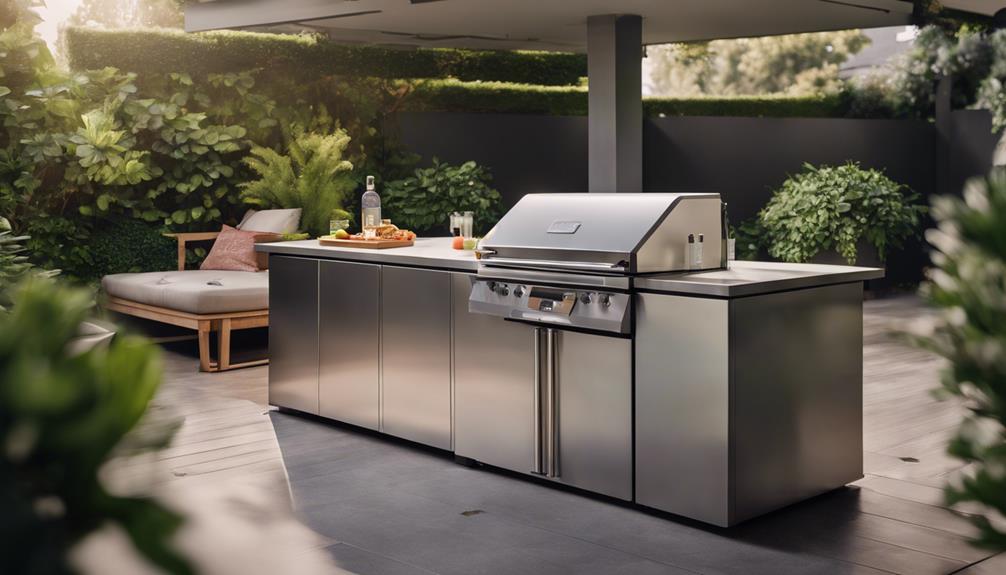
Two types of Alfresco outdoor refrigeration options are available to cater to different outdoor kitchen designs and layouts: built-in and freestanding models.
You'll love how Alfresco's built-in models seamlessly integrate into your outdoor kitchen design, creating a sleek look that's perfect for those who want a streamlined aesthetic.
On the other hand, freestanding models give you the flexibility to place them wherever you want, and you can easily move them if needed.
Either way, you can trust that Alfresco's outdoor refrigerators are designed to withstand the outdoor elements and keep your food fresh.
Whether you choose a built-in or freestanding option, Alfresco provides high-quality and durable outdoor refrigeration solutions that'll serve you well for years to come.
With Alfresco, you can enjoy the convenience of outdoor refrigeration without sacrificing style or functionality.
Top Brands and Models of Alfresco Fridges
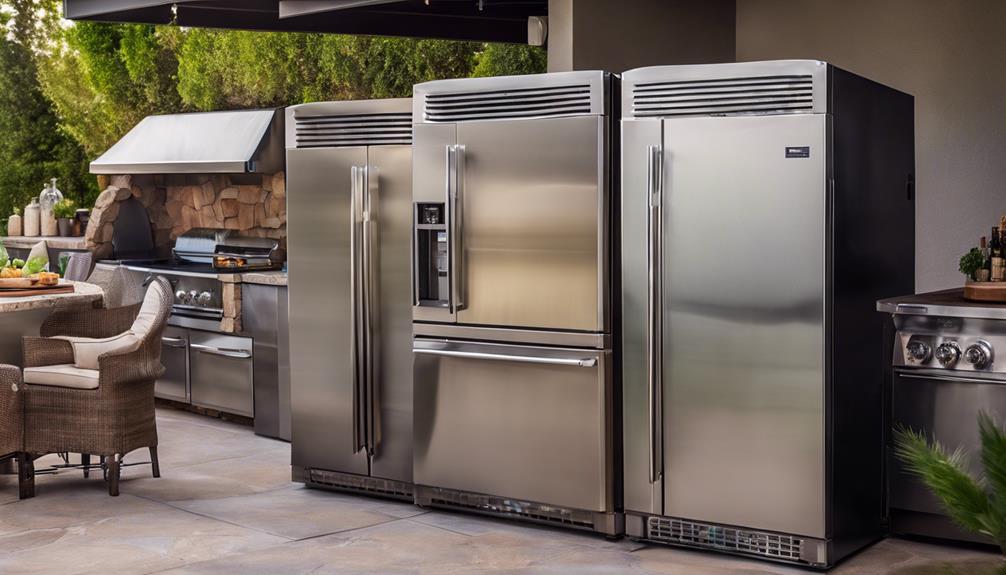
When it comes to choosing the right Alfresco fridge for your outdoor kitchen, you're spoiled for choice with top brands and models that offer exceptional performance and durability. Alfresco, a leading brand, stands out from the rest with its top-quality outdoor refrigerators designed specifically for outdoor use.
Their fridges boast all-stainless steel construction inside and out, guaranteeing durability and longevity. Plus, they're certified to NSF standards, so you can rely on them to keep your food fresh. With a wide temperature range of 27 to 56 degrees Fahrenheit, you can store anything from cold drinks to fresh produce.
Alfresco's fan-driven cooling system ensures constant and even cooling, while adjustable shelves let you customize the storage to fit your needs. And, with digital controls and a front-breathing system, you can easily monitor and adjust the temperature.
Whether you're hosting a backyard BBQ or just want to keep your drinks chilled, Alfresco's got you covered. So, take your outdoor entertaining to the next level with an Alfresco refrigerator that's built to last.
Energy-Efficient Outdoor Refrigerators
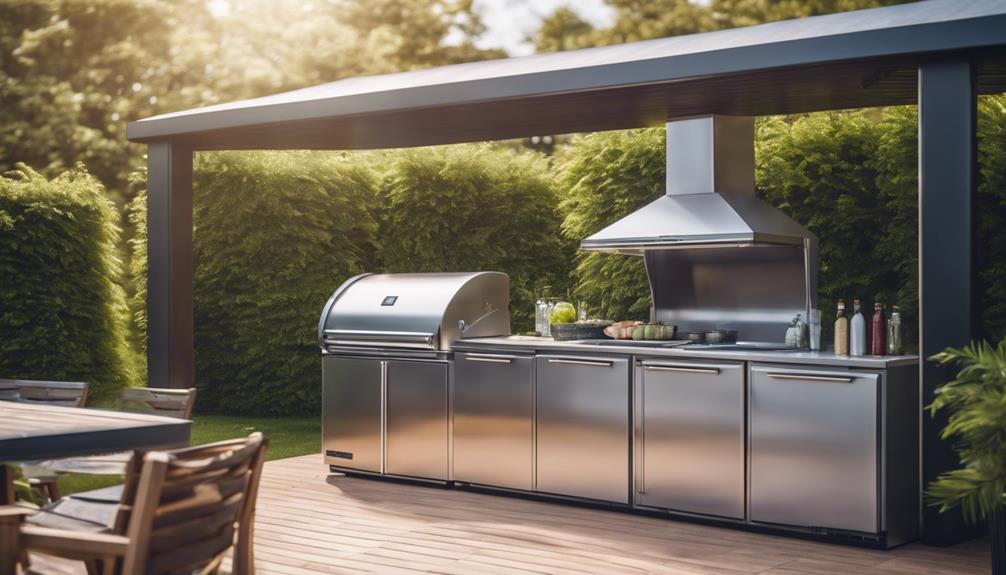
Now that you've got your outdoor kitchen setup, you're probably wondering how to keep your drinks and snacks fresh without breaking the bank – or the environment.
Luckily, energy-efficient outdoor refrigerators have got you covered, featuring innovative cooling tech that keeps your food at the perfect temp while keeping energy consumption low.
Let's take a closer look at what makes these eco-friendly fridges tick!
Outdoor Cooling Technology
By incorporating advanced outdoor cooling technology, you can enjoy consistent refrigeration performance even in extreme outdoor temperatures. This means you can focus on perfecting your outdoor cooking experience, rather than worrying about your food going bad.
Alfresco outdoor refrigerators feature a commercial-grade refrigeration system that's designed to keep your food fresh in any outdoor setting. Here are just a few key features that make this possible:
- Fan-driven fin evaporator cooling: This advanced cooling system guarantees consistent temperatures, even in extreme heat or cold.
- All-weather refrigeration system: This system is designed to operate efficiently in any outdoor conditions, so you can enjoy your outdoor kitchen all year round.
- NSF-certified: Alfresco outdoor refrigerators meet strict NSF standards for safety and performance, so you can trust your food is stored safely.
With stainless steel shelves and a front-breathing system, Alfresco outdoor refrigerators are built to withstand the elements. Plus, with a temperature range from 27 to 56 degrees Fahrenheit, you can store a wide range of foods and drinks.
Whether you're hosting a backyard BBQ or just want to keep your favorite drinks chilled, Alfresco outdoor refrigerators have got you covered.
Low Power Consumption
You can enjoy the perfect blend of performance and power efficiency with Alfresco outdoor refrigerators, which are designed to minimize energy consumption without compromising on their ability to keep your food fresh.
These energy-efficient outdoor refrigerators consume low power while still providing top-notch cooling performance, making them an ideal choice for outdoor kitchens.
By choosing Alfresco outdoor refrigerators, you'll not only reduce your electricity bills but also contribute to a more environmentally friendly lifestyle. These refrigerators are designed to operate efficiently in outdoor environments, ensuring consistent cooling with minimal power usage.
Plus, their cost-effective nature makes them a smart investment for your outdoor space.
With Alfresco outdoor refrigerators, you can enjoy your favorite foods and drinks while keeping your carbon footprint in check.
Eco-Friendly Design
With eco-friendly design at its core, Alfresco's energy-efficient outdoor refrigerators pioneer a new standard in sustainable outdoor entertaining, allowing you to indulge in your favorite foods and drinks while keeping your environmental impact in check.
When it comes to outdoor refrigerators, you might think that 'eco-friendly' means sacrificing performance for the sake of the planet. But Alfresco proves that's not the case.
Here are just a few ways their energy-efficient outdoor refrigerators are changing the game:
- Advanced insulation: Alfresco's refrigerators use cutting-edge insulation to keep your food and drinks at the perfect temperature, while using minimal energy.
- Optimal cooling: Their compressors are designed to provide consistent cooling without guzzling power, so you can enjoy your outdoor gatherings without worrying about your carbon footprint.
- Environmentally responsible design: From design to production, Alfresco's commitment to eco-friendly design ensures that their outdoor refrigerators aren't only energy-efficient but also environmentally responsible.
Installing and Maintaining Your Alfresco Fridge
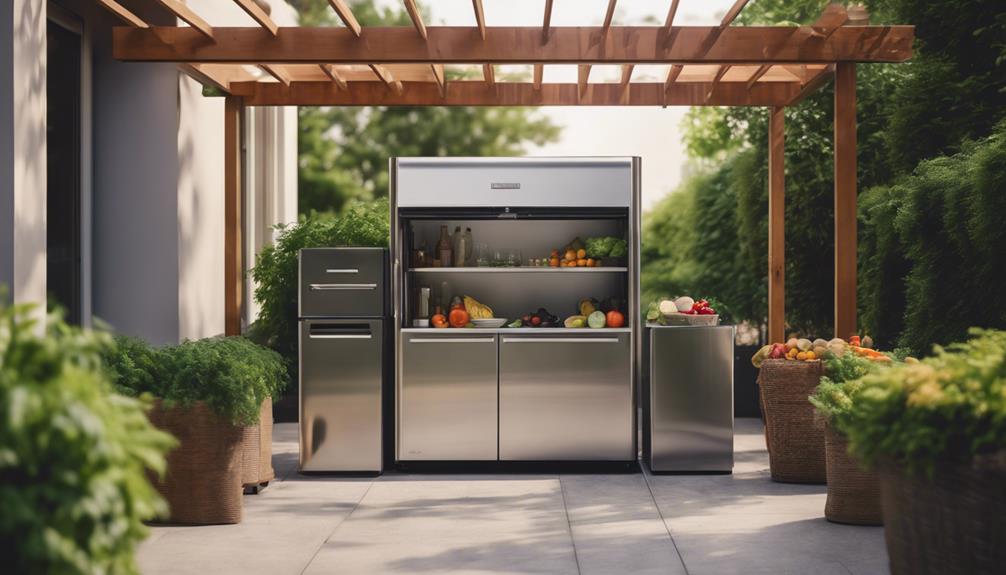
Proper installation and regular maintenance are essential to making sure your Alfresco fridge operates efficiently and effectively in your outdoor kitchen setup. When installing your Alfresco fridge, make sure to take into account a few important factors. You'll want to guarantee proper ventilation, keep it away from direct sunlight, and level the installation surface for best performance. And, don't forget to think about proximity to your indoor kitchen and easy access for convenience and functionality.
To keep your Alfresco fridge running smoothly, you'll need to maintain it regularly. This includes cleaning the interior and exterior, checking and replacing door seals, and defrosting when ice buildup occurs. Don't forget to inspect and clean the condenser coils as part of your maintenance routine – it's crucial to ensuring efficient operation.
Enhancing Your Outdoor Entertaining Experience
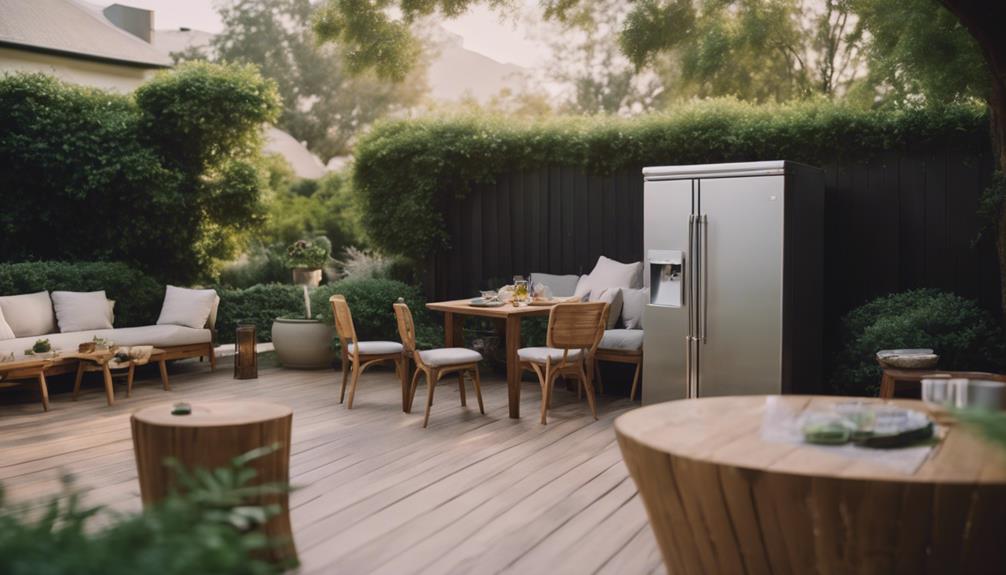
Adding an Alfresco fridge to your outdoor kitchen setup instantly elevates your entertaining experience, providing convenient access to chilled beverages and fresh ingredients right where you need them. With an outdoor refrigerator, you can keep your drinks cold and your food fresh, ensuring that your guests always have what they need.
Here are just a few ways an Alfresco fridge can take your outdoor entertaining to the next level:
- Convenience: No more running back and forth to the indoor kitchen for drinks or snacks – everything you need is right there in your outdoor kitchen.
- Variety: With adjustable shelves and a commercial-grade cooling system, you can store a wide range of items, from beverages to ingredients for your outdoor cooking.
- Flexibility: Convert your Alfresco fridge into a kegerator for draft beer service, or use it to store fresh fruits and veggies for a healthy snack bar.
Frequently Asked Questions
Do You Need a Special Refrigerator for Outdoors?
So, do you need a special refrigerator for outdoors?
Well, yeah, you kinda do! Regular fridges aren't built to handle the elements, like rain, sun, or extreme temps.
Outdoor fridges, on the other hand, are designed to withstand all that and keep your food fresh. They're made with weatherproof materials, like stainless steel, and have features like digital temperature control and commercial-grade cooling systems.
Trust us, it's worth the investment for your outdoor kitchen or patio!
Is It Safe to Leave a Fridge Outside?
You're wondering if it's safe to leave a fridge outside? Well, ironically, the answer is a resounding 'it depends'!
Not all fridges are created equal, and most standard ones aren't built to withstand outdoor conditions.
But, if you've got a specialized outdoor fridge, like the Alfresco, specifically designed for outdoor use, then you're good to go!
Just keep in mind, choosing a fridge that's built to brave the elements is crucial.
How Do You Maintain an Outdoor Refrigerator?
So, you wanna know how to maintain an outdoor refrigerator?
Well, first, you'll want to clean the interior and exterior regularly to prevent dirt buildup. Check and replace those door seals when needed, and don't forget to defrost when ice builds up.
Also, inspect and clean those condenser coils to keep things running smoothly.
What Temperature Should an Outdoor Refrigerator Be Set At?
Here's a surprising fact: did you know that the optimal temperature range for an outdoor refrigerator is between 27°F and 56°F? Yep, it's a pretty specific range!
To guarantee that your food stays fresh and safe, set your outdoor fridge to a temperature within this range.
This guarantees that your drinks stay chilled and your food stays fresh, even in the great outdoors!
Conclusion
So, you've made it to the end of our alfresco fridge adventure! Did you know that 75% of homeowners with outdoor kitchens use their spaces at least 4-5 times a week? That's a lot of fresh food and good times!
With an alfresco fridge, you can join the outdoor entertaining pros and keep your food and drinks fresh and ready to go. Now, get out there and start grilling (and chilling) like a pro!
